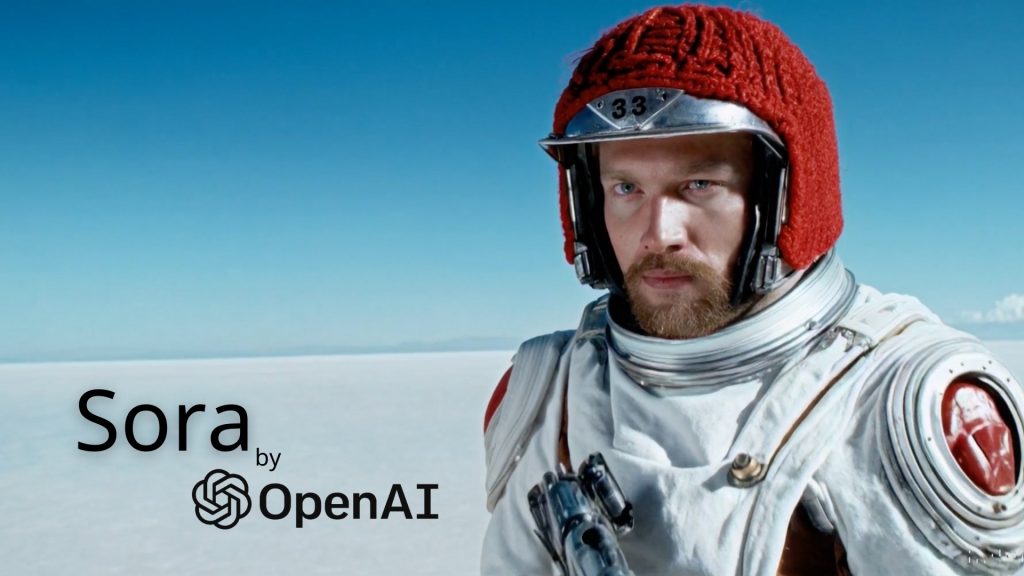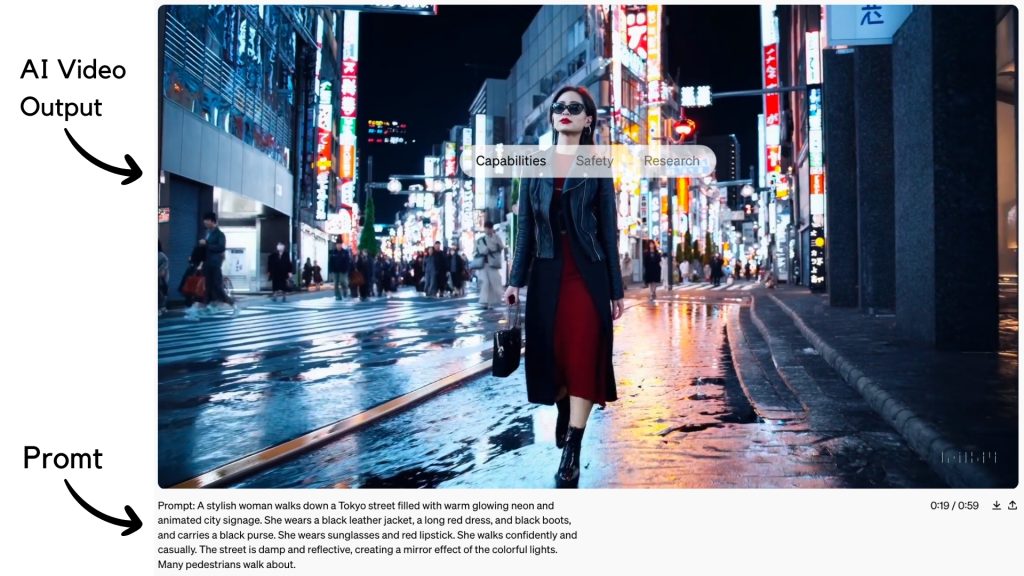OpenAI’s latest innovation, Sora, marks a significant leap forward in the AI and video creation landscape. This cutting-edge tool, powered by generative AI technology, is designed to transform text descriptions into realistic and imaginative video content. The recent announcement of Sora has generated considerable excitement and buzz within the tech community, signaling a new era of content creation. With Sora, OpenAI continues to push the boundaries of AI’s capabilities, further cementing its role as a leader in AI research and development.
The introduction of Sora is not just a technical achievement; it represents a paradigm shift in how creators think about and produce video content. By simplifying the video creation process, Sora democratizes access to high-quality video production, enabling creators, marketers, and educators to bring their ideas to life with unprecedented ease and flexibility. The buzz around Sora underscores the tech community’s eagerness to explore and leverage AI for creative expression, highlighting the tool’s potential to transform the digital media landscape.

What is Sora by OpenAI
Sora’s uniqueness lies in its core functionality—converting text descriptions into video content, a capability that sets it apart from existing video creation tools. This feature leverages advanced AI technology, including natural language processing and generative algorithms, to understand textual inputs and render them into dynamic, visually compelling videos. Such a feature represents a significant technological advancement, enabling a level of creativity and efficiency previously unattainable with traditional video production methods.
Comparatively, while other video creation tools require manual selection of visuals, animations, and effects, Sora automates these aspects, saving time and lowering the barrier to entry for high-quality video production. This automation does not just streamline the creation process; it opens up new possibilities for storytelling, marketing, and educational content by allowing creators to focus more on the narrative and less on the technicalities of video production.
Moreover, Sora’s AI-driven approach provides a level of customization and scalability that is hard to match. Its ability to generate unique and tailored content based on textual descriptions allows for a greater degree of personalization, making each video truly one-of-a-kind. This distinctive feature of Sora not only highlights its technological prowess but also its potential to revolutionize the way we create and consume video content in the digital age.
How to Use Sora
Sign Up or Log In to OpenAI
To access Sora, you would typically start by visiting OpenAI’s official website . If Sora is structured similarly to other OpenAI tools, you’d need to create an account or log in if you already have one. This step ensures you have access to the platform’s suite of AI tools, including Sora.
Navigate to Sora’s Dashboard
Once logged in, look for Sora within the OpenAI dashboard or products section. There should be a dedicated area for Sora where you can start new projects or learn more about the tool.
Start a New Project
Initiate a new video project by selecting the appropriate option, likely labeled something like “Create New Video” or “Start Project.” This action should open a new workspace where you can begin the process of generating video content.

Enter Your Text Description
Sora’s main feature is its ability to create videos from text descriptions. You would be prompted to enter a detailed description of the video you envision. The more detailed your description, the better Sora can understand and generate the intended content. Describe scenes, actions, mood, and any specific elements you want included in the video.
Customize Your Video Settings
Depending on Sora’s features, you might have options to customize your video further. This could include setting the video’s length, choosing a style or theme, and specifying resolution or format preferences.
Generate Your Video
After entering your description and customizing your settings, the next step would be to generate the video. This process might take some time, depending on the complexity of your request and the length of the video.
Review and Edit
Once Sora has generated your video, review it thoroughly. Sora might offer editing tools to make adjustments or add finishing touches to your video, ensuring it aligns with your vision.
Download or Share
With your video finalized, you can download it to your device or share it directly from Sora to various platforms or through social media, depending on the available options.
Experiment with different text descriptions to understand how Sora interprets input and refines your approach to get the best results. Take advantage of any tutorials, tips, or community forums provided by OpenAI to learn more about effectively using Sora.
Creative Use Cases for Sora
Sora, OpenAI’s innovative tool for generating video content from text descriptions, opens up a myriad of possibilities for various fields and applications. Here are some creative use cases for Sora across different domains:
Digital Marketing
- Product Demonstrations: Create vivid, detailed videos showcasing product features, usage scenarios, and benefits without the need for physical prototypes or extensive filming sessions.
- Brand Storytelling: Develop compelling brand stories, weaving emotional narratives that connect with audiences on a deeper level, enhancing brand loyalty.
Educational Content
- Interactive Learning Modules: Produce educational videos that transform complex concepts into easily understandable visual narratives, making learning more engaging for students of all ages.
- Virtual Field Trips: Offer students immersive experiences of historical sites, natural wonders, or scientific phenomena, bringing subjects to life beyond textbook descriptions.
Storytelling and Entertainment
- Short Films: Writers and creators can bring their stories to life, creating short films based on their scripts or story outlines, bypassing traditional barriers in film production.
- Music Videos: Musicians and bands can generate visually stunning music videos from their song lyrics or thematic concepts, offering a new avenue for artistic expression.
Social Media Content:
- Trending Challenges: Quickly produce videos responding to or participating in social media trends and challenges, keeping content timely and relevant.
- Personalized Messages: Create unique, personalized video messages for special occasions, announcements, or to engage with followers in a novel way.
Below is an example of how your video export would look:
How to Use Sora to Make Money
Content creators can explore various strategies to monetize videos created with Sora, leveraging the unique capabilities of AI-driven content to generate revenue. Here are some effective approaches:
Monetizing Sora-Generated Content
Ad Revenue and Sponsored Content
- YouTube and Social Media: Upload Sora-generated videos on platforms like YouTube, where you can earn through ad revenue. Craft engaging and high-quality content that attracts views and subscriptions.
- Sponsored Videos: Partner with brands to create sponsored content. Use Sora to produce innovative and compelling videos that align with the brand’s message, offering a fresh perspective to promotional content.
Educational Courses and Tutorials
- Online Courses: Create educational content or tutorials in niche subjects using Sora. Sell these courses on platforms like Udemy, Coursera, or your website.
- Webinars and Workshops: Offer exclusive webinars or workshops, using Sora-generated videos to illustrate concepts or demonstrate skills.
Subscription Models and Premium Content
- Patreon and Membership Sites: Offer exclusive Sora-generated content to subscribers or members on platforms like Patreon. This can include behind-the-scenes videos, early access to content, or exclusive video series.
- Video-On-Demand: Create a library of video content available for purchase or rental. Use Sora to produce unique content that caters to specific interests or niches.
Content Licensing and Syndication
- License your Sora-generated videos to media outlets, educational institutions, or content platforms. This can provide a steady income stream for high-quality, original video content.
Merchandising
- Use Sora to create engaging storylines or characters that can be marketed as merchandise. This approach works well for creators with a focus on storytelling, animation, or character-driven content.
Best Practices and Tips for Using Sora
To maximize the potential of Sora and enhance the quality of the videos created, consider the following best practices and tips:
- Be Specific: Provide detailed descriptions, including settings, emotions, actions, and any specific elements you want in your video. The more detail you provide, the better Sora can visualize and create your content.
- Use Storyboarding: Before submitting your description to Sora, storyboard your idea. This can help clarify your vision and ensure your description is comprehensive.
- Iterate: Use Sora’s initial outputs as a starting point. Refine your descriptions based on the results and iterate until you achieve the desired quality.
- Customization Features: Take advantage of any available customization options within Sora, such as adjusting color schemes, style, or incorporating specific visual elements, to enhance the aesthetic appeal of your videos.
- Misinterpretation of Descriptions: If Sora misinterprets your descriptions, try rephrasing your inputs or breaking them down into simpler, more direct statements.
- Quality and Rendering Issues: For issues related to video quality or rendering, check if there are any settings or preferences that can be adjusted. Ensure your descriptions are clear and leave little room for ambiguity.
- Stay Updated: Keep abreast of any new features or updates to Sora. New functionalities can offer additional ways to enhance your video creation process.
- Community Engagement: Engage with the Sora user community. Sharing insights, tips, and creative uses can provide new ideas and solve common challenges.
To stay competitive in this rapidly evolving landscape, creators and businesses will need to embrace AI-driven content creation tools like Sora. By experimenting with these technologies, they can discover new storytelling techniques, streamline production processes, and engage with audiences in innovative ways.
How Sora is Trained
The technology underpinning Sora is a testament to OpenAI’s advancements in AI and machine learning. Here’s a closer look at how Sora interprets text descriptions to generate video content:
Natural Language Understanding (NLU)
At the core of Sora’s functionality is its ability to comprehend complex text inputs. Using advanced NLU algorithms, Sora analyzes the semantics and nuances of the text, extracting key information, themes, and visual descriptors to guide the video generation process.
Generative AI Models
Sora leverages generative AI models, likely building on the foundations set by predecessors such as GPT (Generative Pre-trained Transformer) and DALL·E. These models have been trained on vast datasets of video content and associated metadata, allowing Sora to understand how textual descriptions correlate with visual elements.
Scene Composition and Rendering
Once Sora understands the text input, it uses AI-driven scene composition algorithms to layout the visual elements, sequence actions, and render scenes. This involves choosing appropriate backgrounds, characters, objects, and animations that match the description and assembling them into coherent video sequences.
AI-Driven Animation
For dynamic elements and character movements, Sora likely utilizes AI-driven animation techniques. These techniques enable the generation of natural movements and behaviors based on the context provided in the text, adding life to the generated videos.
Customization and Refinement
Sora may incorporate machine learning models that allow for style transfer and aesthetic adjustments, enabling users to specify the visual style or mood of their videos. Additionally, feedback loops could be used to refine video outputs based on user corrections or preferences, enhancing the quality of generated content over time.
The intersection of NLU, generative AI models, and AI-driven animation represents the technological synergy that makes Sora a groundbreaking tool. By harnessing these technologies, Sora is poised to redefine the boundaries of video production, offering creators a powerful platform for bringing their visions to life.
Conclusion
Sora by OpenAI represents a leap forward in the realm of content creation, offering unprecedented capabilities for turning text into rich, engaging video content. Its introduction is a pivotal moment for creators and businesses alike, signaling a future where the boundaries of creativity are significantly expanded by AI.
The transformative potential of Sora extends across various industries, from filmmaking and marketing to education and beyond. It not only streamlines the video production process but also democratizes access to high-quality video content creation, enabling anyone with a vision to bring their ideas to life.
As Sora and similar technologies continue to develop, embracing these tools will be crucial for staying ahead in the digital media landscape. Creators and businesses are encouraged to explore Sora, experiment with its capabilities, and consider how AI-driven content creation can be integrated into their workflows. The future of video creation with Sora is not just about harnessing the power of AI but also about unlocking the full potential of human creativity in harmony with technological advancement.











